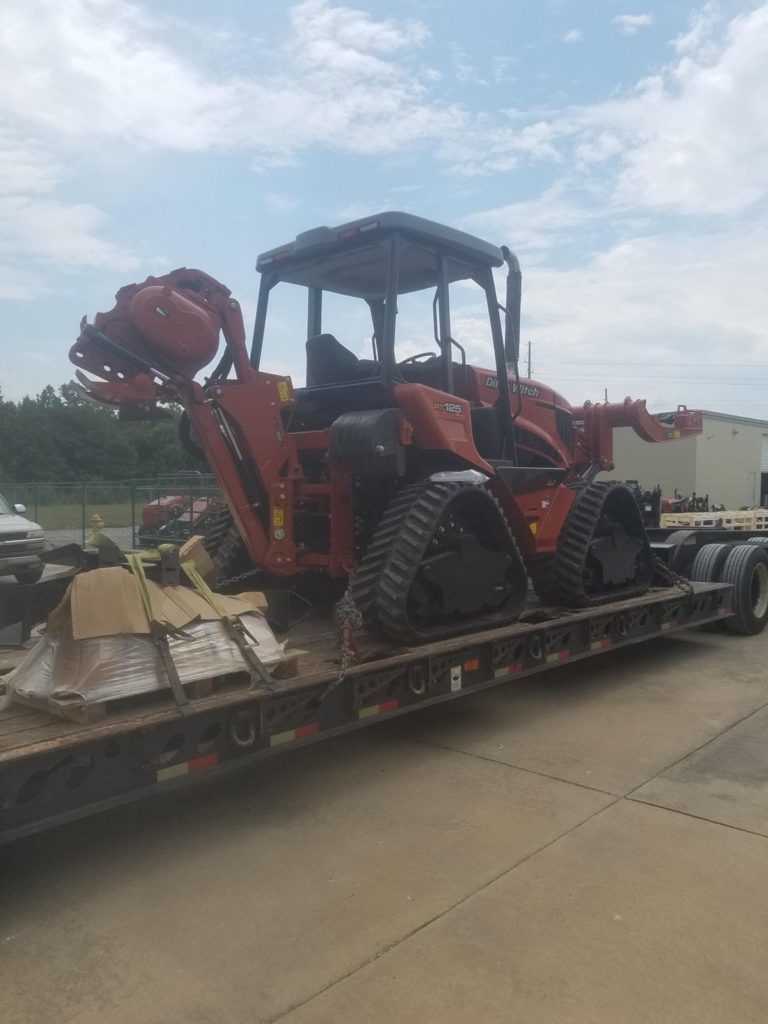How to Load a Trencher
Preparing Your Trencher for Transport
A lot of preparation goes into the transportation of a trencher. The crew must follow strict safety and risk-reduction practices for safe loading, hauling, and unloading. A trencher is a piece of heavy equipment with a load that exceeds 10,000 lbs. Transporting such a piece of heavy equipment requires the services of a professional heavy hauler because they have the necessary rigs to handle industrial-grade consignments. Reputable heavy-cargo freight companies like Heavy Hauler also follow proven operational protocols when handling significantly valuable digging machines. They have to put on every i and cross every t, because if any mishap should cause weakness on any component of the machine, it may affect transportation.

Trencher Shipping: Trailer Conditions for a Long-Distance Haul
The most appropriate trailer for use is a Removable Goose Neck (RGN) trailer. Considering that the trailer is an integral part of the assembly involved in actual transportation, it is essential to inspect it, as well as the tractor.
First, check the condition of the tires and the brakes. When assessing the tires, you want to make sure that each has the recommended pressure limit. Most heavy-cargo consignments have massive weights that affect tire pressure, and can quickly deflate them [tires] if they already contain inadequate pressure. Heavy equipment can also impact the braking ability of the towing truck and trailer. Ensure that the brakes and other related components are in their best shape to handle the shipment.
The security of the cargo in the trailer is paramount. That has a lot to the tie-down chains and their working load limits. Some critical aspects to focus on include the number of tie-down points required for the load, their conditions, and spacing. Shipments involving equipment with over 10 tons of weight require at least four tie-down points, complete with a binder, boomer, and chain to secure the load on trailer hitches.
Loading a Trencher for a Long Haul
Heavy Haulers is committed to hauling the trench diggers reliably and legally. Our expert truckers refer to standard loading operations and safety codes. Before the loading procedure begins, a company’s logistics crew embarks on looking for the appropriate trailer. A trench digging machine moves through crawlers. Hence, using ramps to load the equipment presents a challenge. The equipment operators will have an easy time lowering and raising a Removable Gooseneck (RGN) trailer platform, when loading and offloading the cargo.
The next step in the loading procedure is cleaning the ramp and trailer deck. That ensures that there is enough traction to displace the trailer bed upward. The trailer should be free of snow, oil, water, and debris, among others. If you want to further step-up traction, you can deploy a friction device on the trailer.
How to Load a Trencher on Uneven Ground
Another crucial step is to find a clear and even ground to load the trench digger. If you operate in a crowded area, the chances of the plans going as planned dwindles. Loaders also need to find an actual ground to load the heavy equipment. The weather also affects operations. For instance, when the ground is wet, the combined weight of the trailer, tractor, and the heavy load may cause the ground to sink.
A driver will then steer the trencher on the trailer. Here the trailer deck is lowered to ground level to allow the machinery to move into position quickly. The trailer will proceed with the chain and cup teeth assembly facing the rear side of the trailer. A spotter will help the driver and signal the driver on the appropriate position of the digging machinery. The rear axles and the tractor then come into position for attachment. The trailer bed is then raised, and any overload flags put in place for road safety.
Factors to Consider When Transporting a Trencher
We’ve heard so many reports about road accidents caused by heavy-equipment haulage. To prevent this, Heavy Haulers ensure that we put measures maximize road safety.
– We plan out the shortest, most linear path before time
– We retrieve the transportation permits
– We remove the wheels from the equipment to prevent them from rolling on deck. It alleviates safety risks and lowers the center of gravity of the load
– Outfit the tractor with oversized-load signals, banners, and flags
– Document the transport logbook at every stop or driver change depending on the transportation policies.
Transport Your Trencher With Heavy Haulers Today!
Step 1: Fill Out Quote Form
Fill out the short & easy quote form.
Step 2: Speak With An Agent
We’ll pick up your heavy equipment or vehicle.
Step 3: Get Transported On Time
We deliver on time so you can get back to work.